Sea Kale – identification, edibility, distribution, ecology, sustainable harvesting, recipes
Sea Kale – Crambe maritima
- Edibility – 5/5 (1/5 – Roots – should not be uprooted, but you may occasionally find roots washed out by storms), 5/5 – young shoots, 2/5 – old leaves, 5/5 – flower buds & heads, 4/5 – seed pods). One of the truly great wild foods.
- Identification – 4/5 – Hard to mistake. All stages, from the strange purple shoots through the large, thick, squeaky green/blue leaves to the honey-scented cruciferous white flowers and the pea-like seed pods, are pretty much unique in this habitat. See images below.
- Distribution – 2 – Occasionally locally abundant, but under some pressure in certain areas. Pick leaves, buds, flowers with consideration for the individual plant and the context within which it is growing. Be careful not to tread on the young purple shoots. In Britain, sea kale has been reported to have declined in certain areas but increased in other areas and currently does not have rare or scarce status (Decocq, 2015). Loss of sea kale has been disproportionately high in southern England primarily due to gravel extraction and building (Doody & Randall 2003). Given the habitat in which it grows, I don’t find it surprising that sea kale colonies can fluctuate. One of the colonies that I regularly visit took a terrible pounding from a winter storm one year, resulting in it becoming less abundant for a few years, but the colony has since recovered and is now bigger than ever, only with a higher proportion of younger plants. Sea-kale grows on substrates more or less rich in organic matter and nitrogen compounds from the decomposition of seaweed at high drift lines. It can, however, also grow in nutritionally poor and saline soils.
- Season – Shoots & young leaves March – May (though it is possible to find late “self forced” shoots in the shade of the large later leaves), Florets (unopened flower heads – like broccoli) May – June, Seed pods June – July (seed pods are generally only worth eating for a very short period of succulence (c. 2 weeks), after which they become too hard to eat). Roots are available all year, but hard to spot when they don’t have any leaves etc.
- Habitat – Shingle and coarsely sandy beaches, occasionally rocky shores, on stable substrates above the high tide line which have been stable over 5–20 years. It very rarely spreads inland, though its likely that some have escaped from gardens back into the wild in some locations.
- Ecology – Sea kale produces hermaphrodite flowers that both self- and cross-pollinate. Pollination is by insects, flies and bees, and a colony of mature sea kale in full flower buzzes with life, even in windswept locations that tend to have less insects. Fully grown plants can produce 1000–10 000 seeds per year. The taproots have a strong capacity to reproduce and regenerate (Briard, Horvais & Péron 2002). The extensive root and rhizome systems provide the resources necessary for reproduction by subterranean growth and emergence, and also enable renewed growth after erosion, because of their ability to regenerate from plant fragments. I’m no gardener, but when I found sea kale shoots smashed apart and washed up by a storm, I rescued a few, which grew and sprouted readily in pots in my garden, and I replanted them in the wild the following year. Plants usually take at least 5 years to produce flowers, and in the large colonies I visit, what I think of as “nursery beds” of immature plants, usually occupying a slightly lower position on the shore than larger, well established flowering specimens . This lower location is more susceptible to tidal movement and erosion, so there is a higher turnover of plants. The seeds are borne in an ingeniously evolved pea-like casing, that becomes “corky” as it matures, allowing it float for several months, and be cast by tides to new locations.
- Sustainable Harvesting – Uprooting of sea kale seems like a very poor prize at a high cost, and should not be done. Individual plants, or isolated groups of just a handful of plants should be left alone. Young purple shoots and florets can be sustainably harvested from healthy colonies by removing just one or two from mature plants, then moving on. A traditional practice is to pile shingle and seaweed on top of young shoots (in the same manner as forcing rhubarb) which results in longer, paler, more tender stems after a couple of weeks. Personally, I find this unnecessary as the young shoots are delightfully succulent as they are, and elongated shoots form naturally later under the shade of mature leaves – have a rummage! Flowers and seed pods should be harvested with similar restraint, being sensitive to the relative abundance of the plants. If in doubt, consider observing the colony for a few seasons, so you gain an understanding of how it is doing. As always, thinning abundance should be a responsible forager’s mantra!
Even if it wasn’t edible sea kale would still be my favourite plant (well, maybe equal with common hogweed). Its alien-looking purple shoots, sculpturesque leaves and clouds of nodding flowers are works of high art to intoxicate the senses and marvel the mind. As luck would have it, it also happens to be absolutely delicious, providing some sort of food for most of the year. I place it on a par with ceps, reedmace, hogweed and spoot clams in the pantheon of wild food gods.
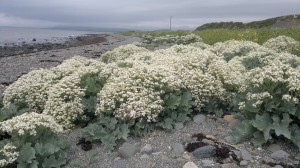
A cloud of sea kale in full flower, May
The youngs shoots are great raw in salads, or as crudités (especially dipped in wild garlic pesto, which is in season at the same time). They are also good lightly steamed, tossed into a stir-fry, or poached in seaweed ramen.
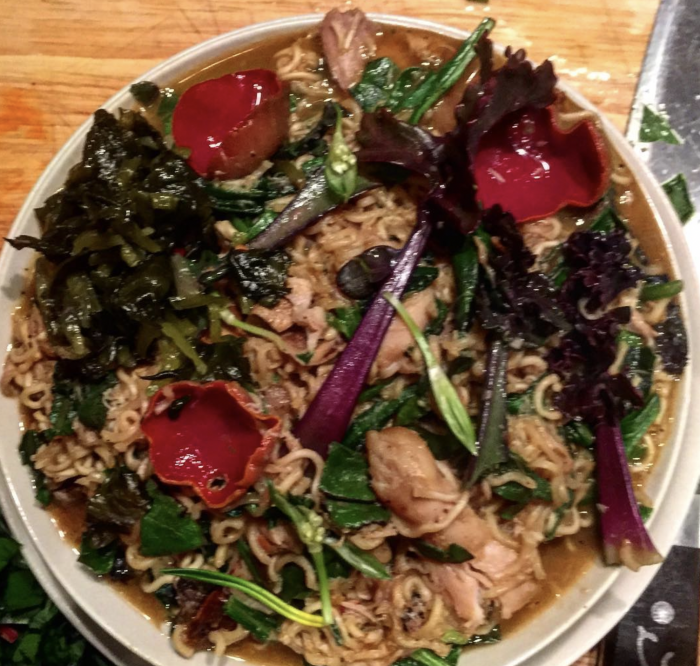
Ramen with sea kale, scarlet elf cups, wild garlic and seaweeds
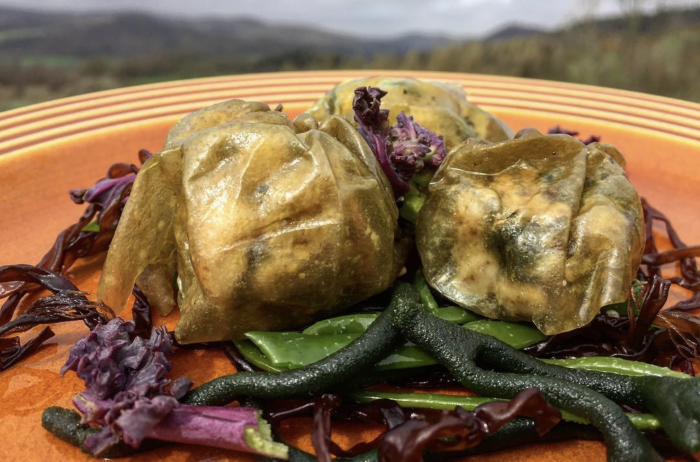
Stuffed oyster thief dim sum, with sea kale and velvet horn
Once the florets form, treat them just as you would purple sprouting broccoli – as a vegetable for all occasions. I have tried a few methods of preserving this remarkable glut of young shoots and florets, but my efforts have been mostly unsuccessful. Being reasonably closely related to cabbages, you might expect them to ferment well, kimchi style. But all my efforts (and i’ve made a few) have tasted deeply unpleasant – bitter and sulphurous – despite the fermentation having worked successfully (ie. the plants ferments, but tastes awful!). Pickling in a cold vinegar solution (3 parts vinegar to 2 parts water to 1 part sugar, or thereabouts) works slightly better, but still bears little resemblance to the delightful fresh version.
The best way I have found of putting some by is to blanch – freeze them. That is, add small quantities of the washed shoots and florets to vigorously boiling water for 2 minutes, then cool rapidly in iced water before draining and freezing.
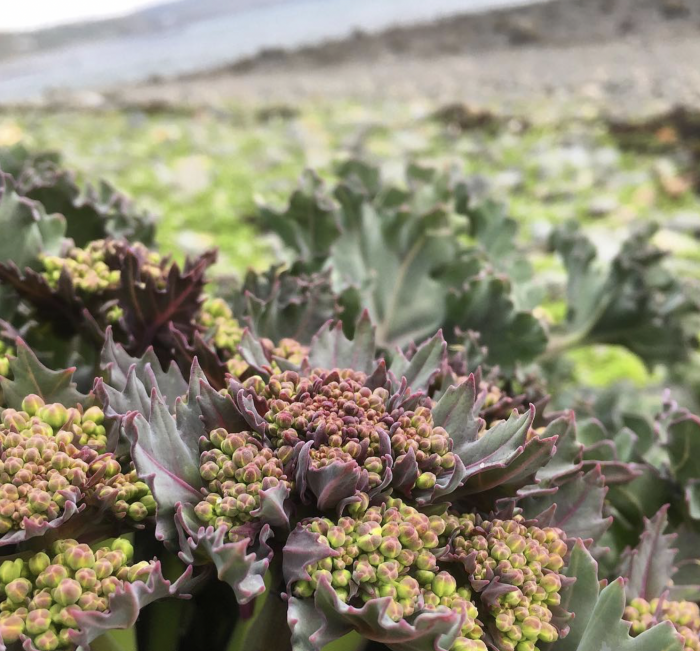
Sea kale florets – like extra-fine purple sprouting broccoli
Apparently sea kale was once a common sight above the high tide mark on many of Britain’s shingle beaches, but is now restricted to sporadic colonies and clusters. This is mostly due to a Victorian penchant for digging them up and transplanting them to ornamental gardens. As always, habitat loss is also an issue: the construction of sea defences has been the death-knell of many a colony. More often than not nowadays, the tramping of young shoots by careless walkers is their biggest threat. Considerate foraging of a few parts of each plant is unlikely to have much impact on these deep-rooted perennials, and I feel that foragers can have a role to play in safeguarding and reintroducing these beautiful plants.
I am fortunate to live quite near a few large and well established colonies which keep me in delicious greens for most of spring and early summer. I know several sites with only one or two plants. Whether these are the beginnings of new colonies or the last vestiges of receding ones, I leave them to their rather wonderful business.
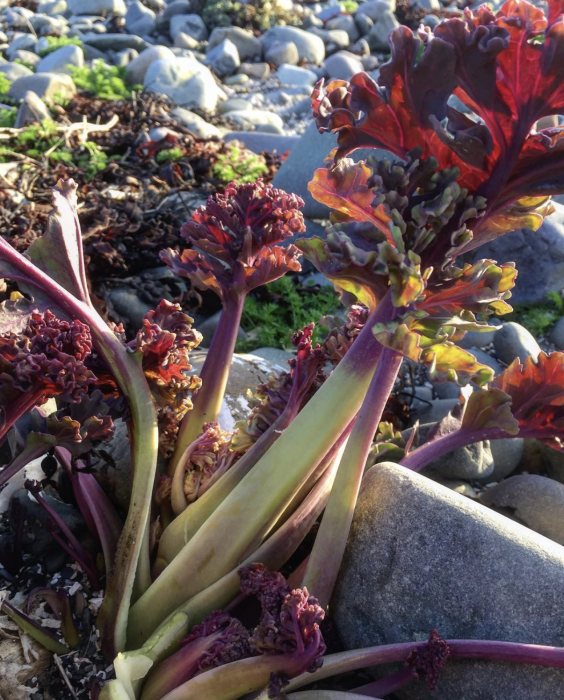
Naturally forced sea kale shoots. Where the sea deposits pebbles, shingle, driftwood and seaweed on emerging sea kale shoots, they develop long, pale tender stems in their stretch for light. This adds extra deliciousness to an already scrumptious vegetable. Some sea kale aficionados will deliberately ‘bank up’ emerging plants to create forced shoots, but I prefer to enjoy them as a wee bonus when nature decides.
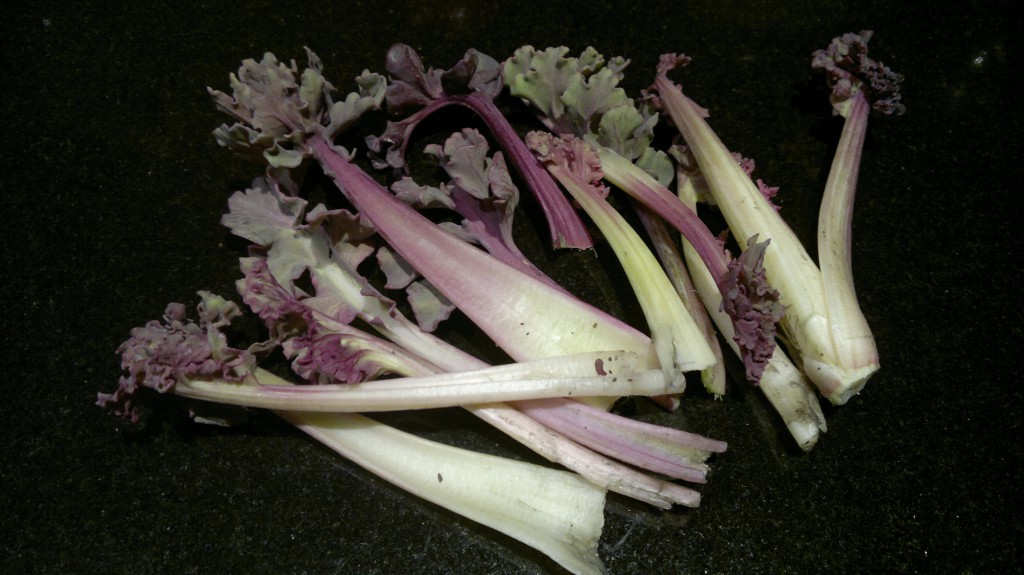
Young sea kale shoots, at their optimum size and condition for eating. Shoots like this can be gathered from among larger, less palatable leaves for most of the growing season.
I hope everyone can experience and enjoy the sensual and gastronomic delights of sea kale, without impacting on its place in the world. I suspect that foragers will cherish and enjoy this plant so much, they are much more likely to contribute to its success and distribution than undermine it.
Here is a photo-tour of a year in the life of this remarkable plant:
Sea kale is a native perennial, over wintering in a deep and extensive root system. All that is evident in winter is the top of the root and some large, dead leaves. The roots are edible, but apart from needing a JCB to get them up, it would be a crime (legally and metaphorically) to dig them up. I have read that hey don’t have much culinary merit anyway.
This rather grim picture was my first sight of sea kale, giving few clues of the beauty to come…
During February the first signs of life start to appear, with deep purple shoots emerging from the woody root-tops.
By mid March, striking deep purple coral-like shoots will develop. At this stage the leaves are succulent, crisp and tender, with a sharp cabbagy pepperiness and make an amazing centrepiece to any salad. If you are tempted to try a couple at this stage, resist and completely bury the shoots in shingle. If you return in a few weeks time, the shoots will have forced their way up and yield lovely long stems that can be cooked like asparagus.
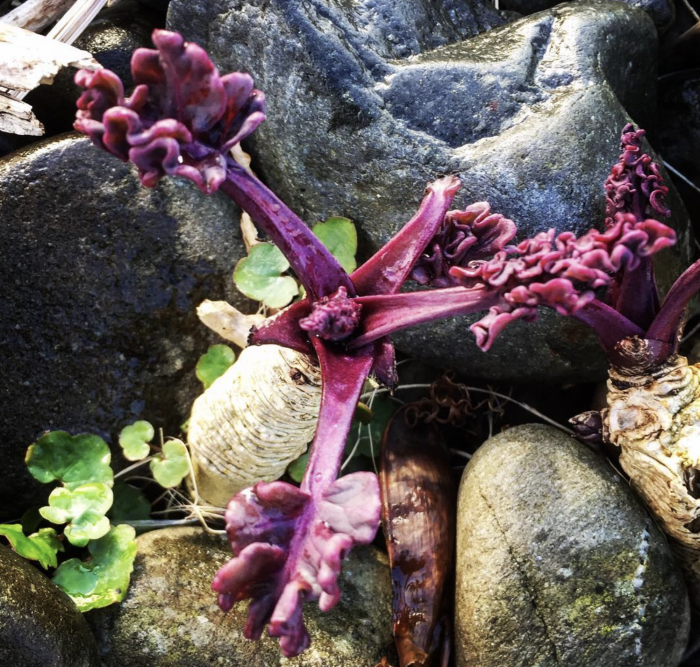
Sea kale young shoots, late March, Galloway
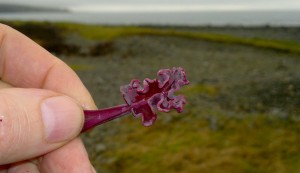
Young sea kale shoot, March
By mid April the earlier weirdness will be starting to resemble something rather more cabbagy, with the leaves thickening and taking on more green hues. Leaf colour can be quite variable between two neighbouring plants – most commonly they are greenyblue, to rich greens and purples.
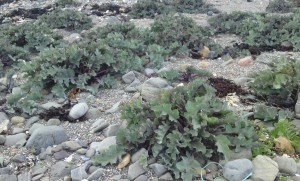
Sea kale, Mid April

Sea kale, mid April
Flower heads start to form in mid April to May. They are a delight, and can be used just like purple sprouting broccoli.
By mid-May, most of the flower heads should have opened out into fabulous crowns of small white flowers and if you are among a large colony, you will be intoxicated by the honied scent of the blossoms. They taste as good as they smell and make a striking and delicious accompaniment to meat and fish. The stems taste mildly of pea and cabbage which combines remarkably well with the sweetness of the blossom. I have seen seasoned michelin starred chefs get as giddy as a child in a sweetie shop when introduced to this for the first time! The leaves by now will be getting large and thick, but you should still be able to find young, tender ones if you delve through the foliage.
By summer, some of the leaves may be a much as 2 feet long by which time they will have become tough, bitter and in need of a lot of cooking if you plan to eat them. I have had success cutting them into long ribbons and cooking like tagliatelle. A word of warning here though: my wife and I once ate a delicious fully-foraged meal of Wigtown Bay sea bass stuffed with sorrel and sweet ciceley served on a bed of mature sea kale leaf tagliatelle. It left both of us at a rapid rate of knots in liquid form exactly 30 minutes later and sea kale was the most likely culprit! I should add that there were absolutely no other ill effects, it simply left us feeling light and purged. I’m sure there are Hollywood starlets that would pay a lot for such an ingredient!
As summer gets going, strange round translucent green fruits appear. They look like peas and taste like cabbage and are the final wonderful twist in the life-cycle of this remarkable plant before it dies back to escape the winter storms.
Related Posts:
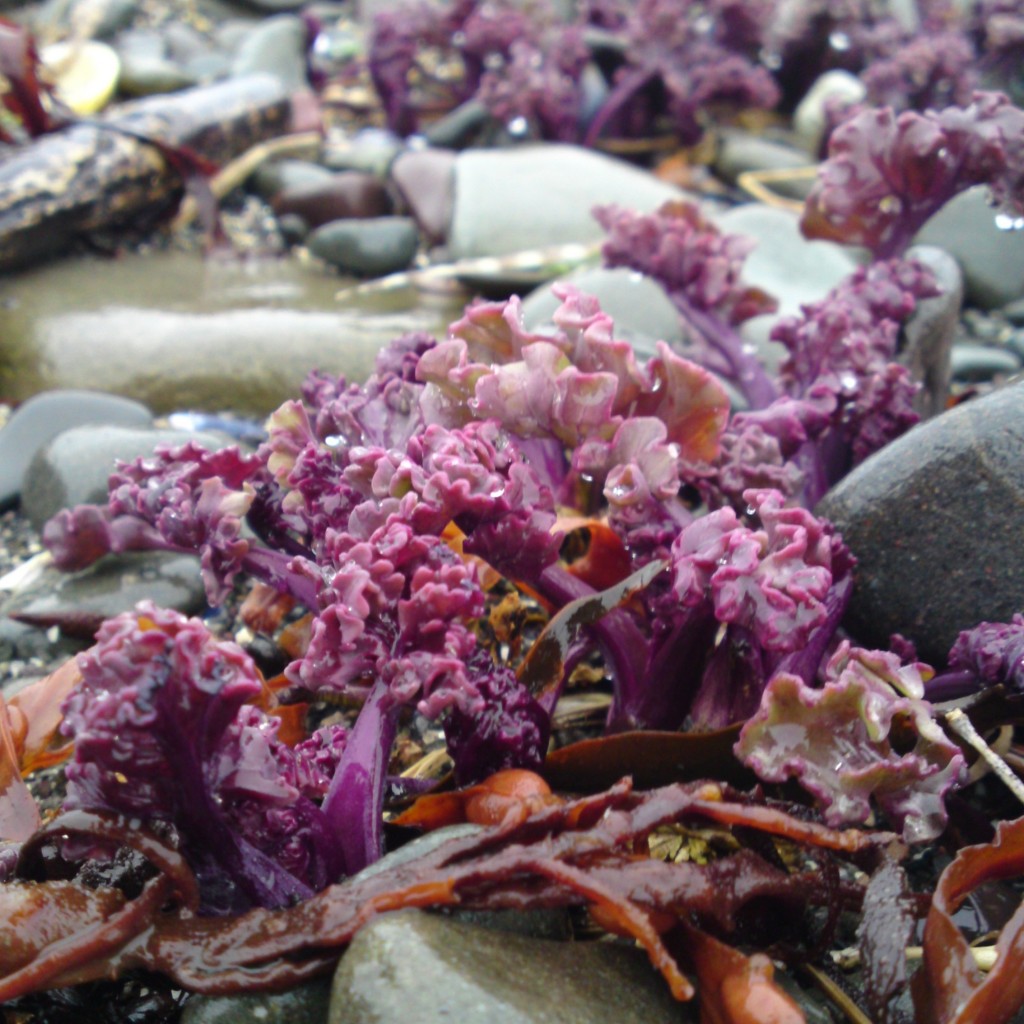
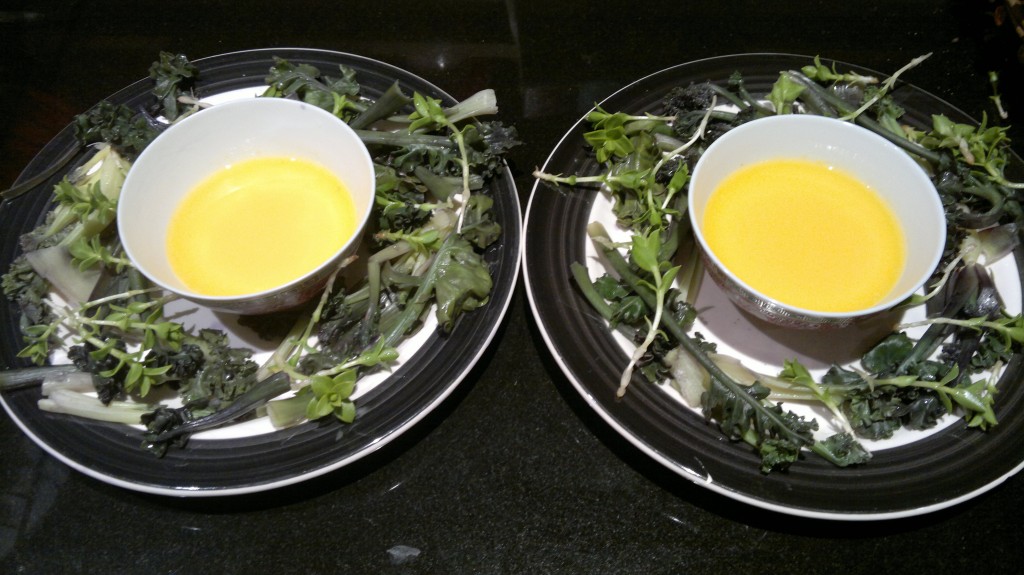
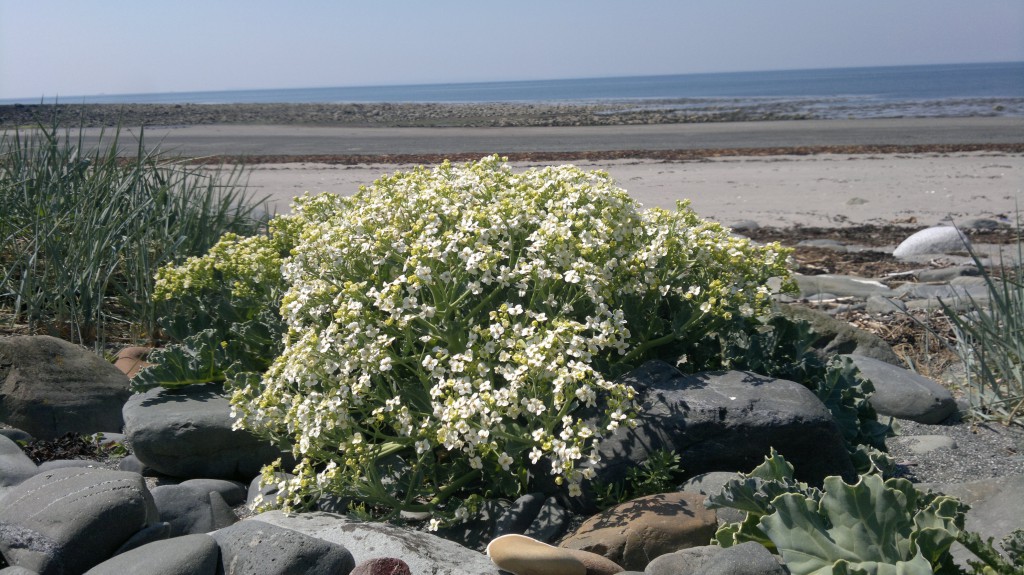
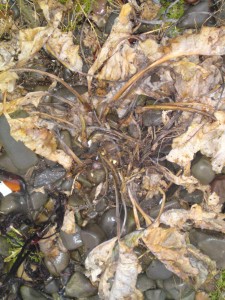

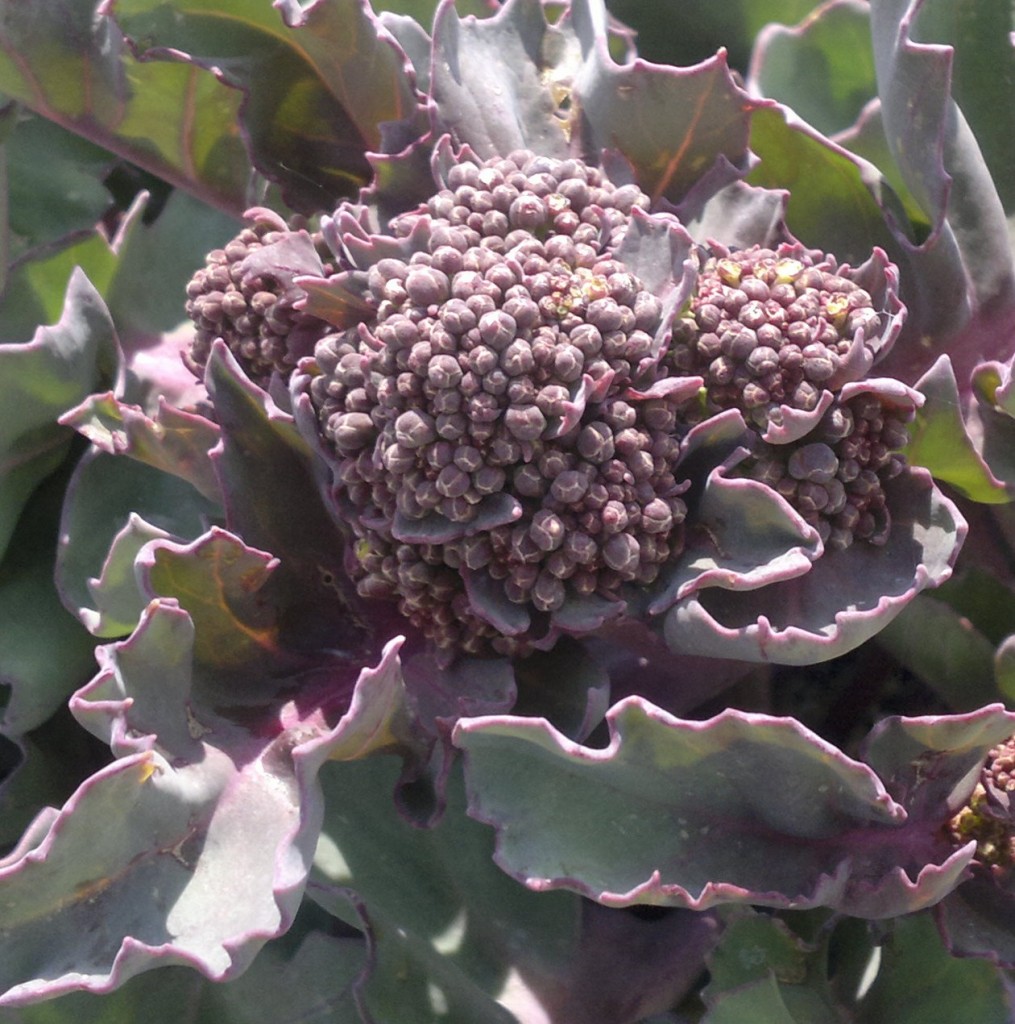
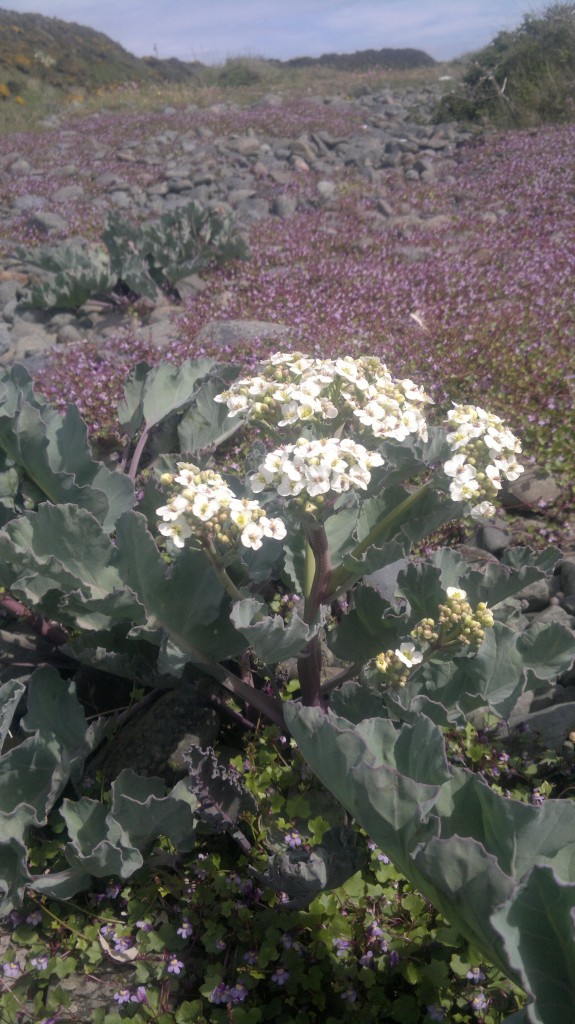
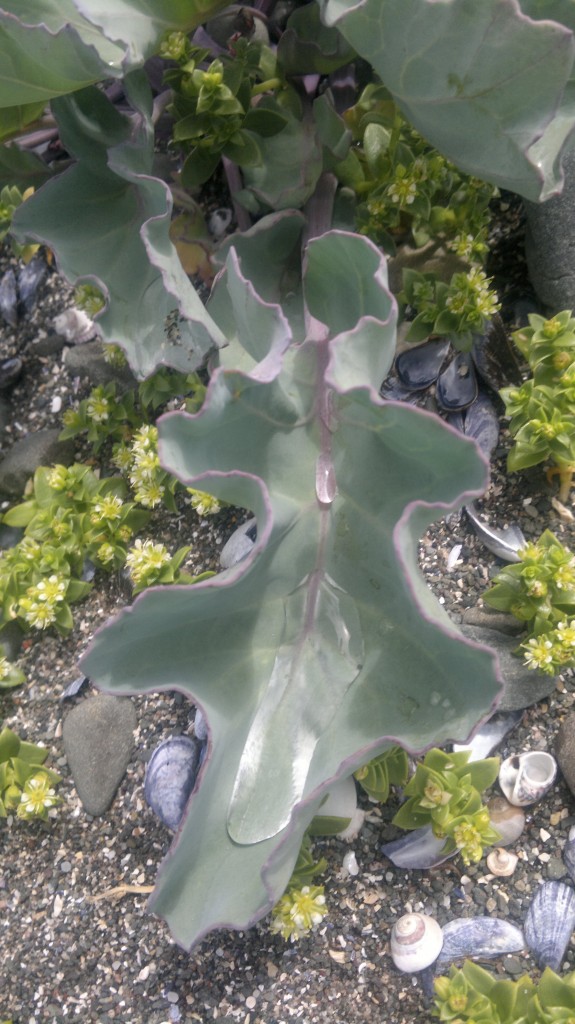
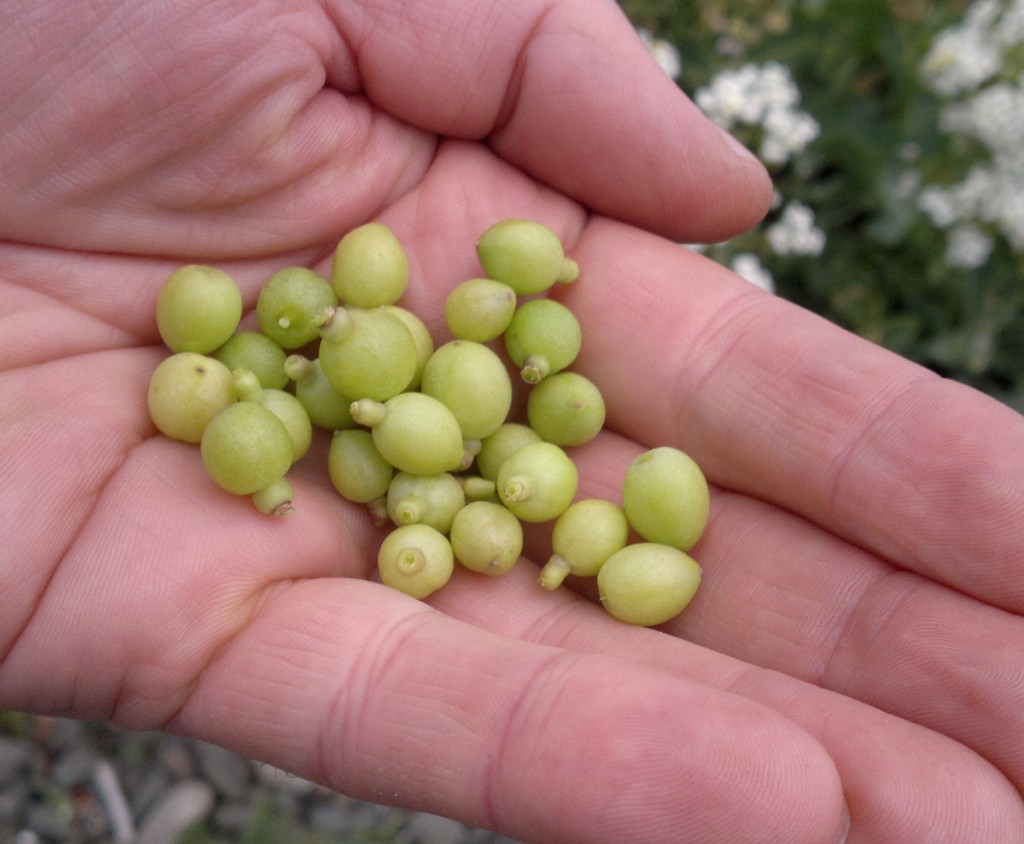
26 Comments
Really interesting, thank you. I’m enjoying learning more about the wild flora on Suffolk vegetative shingle at the moment and have seen Sea Kale and Sea Pea. Do you eat the latter too?
Thanks. I eat some vetches (see wild plant guide), but not sea pea. Many in this family are only marginally edible, after extensive prep. Though I am yet to fully explore possibilities.
I first saw this triffid of a plant in the wild about 10 years ago by a seaside car park where sand dunes meet man made shale (its a long story) when it developed its wonderful budding flower heads I decided it was a broccoli plant escaped from near-by fields.
I nibbled a raw bit and WOW broccoli was never this good… I realised what it must be and looked it up to be sure, but this was the only plant I could find so I wouldn’t harvest from it.
Over the next two autumns I gathered the seeds and spread them along a mile and half of coast where they have now taken off and are happily spreading themselves.
Did you know that The victorians would earth up around them to get blanched stalks for eating, the shale often does this naturally.
Great to hear that you’ve met and got to know this lovely plant. Good work in helping it along. I mention the blanching of the stalks in the article. Later in the year, many of the stalks “self-blanche” among the shade of the earlier foliage. Well worth a rummage!
I think I may have some growing on the allotment. I grew it from some chunks of root that someone gave me. The leaves look almost identical in shape and colour to the ones in the picture, but it hasn’t flowered. I’ve read that it can be confused with sea kale cabbage, but I’ve yet to find any descriptions/pictures that can help with a positive ID.
Do you have any thoughts on this?
Cheers,
Andy.
Sea kale will regrow from pieces of root stock. Wild cabbage is different, developing over time, a long, woody stem. Both are good eating.
Is this the plant that grows down Portwilliam shore Rd, bit like oilseed rape
No, that would probably be sea radish:
I recently picked a couple of larger leaves with the idea of adding to my super green smoothie. How much would you recommend? Thanks.
Errr…not sure I can be helpful on that! Depends on your taste, and what else is in it I guess…
Hello Thankyou for your wonderful photos/ explanation! I saw on a shingle bank near me what I thought to be sea kale , then lo and behold it grew broccoli ‘trees’ …either way I’ve picked a little to add to my salads …greatly enhanced! Can’t wait to monitor its many stages!
I love this plant and it grows near me on dunes amongst the marram on a beach in Cornwall..won’t say where as there are not a great deal there, despite one being of enormous size and ‘presence’, it must be said. I think there is Sea Beet nearby too. Our dunes are wonderful, packed with amazing plants including the sea daffodil, but under constant threat of tampering with/destruction by the often non-environment-friendly Environment Agency in their mission to create ugly, intrusive sea defences everywhere now. Thank you for the encouragement to forage a little of this marvellous plant..have never quite known how edible it was before.
Fantastic info, thanks! I’m harvesting and enjoy this, having recently found some on a bike ride. But why would it give you the runs once and not other times?
It was the very mature leaves that had that effect. The chemical make-up of a plant alters as it develops. This reaction may just have been about the very specific interaction of that plant, at that age and how I prepared/cooked it. Just mentioned it here so folk have a heads-up!
It was the very mature leaves that had that effect. The chemical make-up of a plant alters as it develops. This reaction may just have been about the very specific interaction of that plant, at that age and how I prepared/cooked it. Just mentioned it here so folk have a heads-up!
How do you eat the ‘pea’ bits?
As peas! 🙂
Thank you for the excellent article Mark. I found a couple of sizeable crops in D&G last year, a little too late unfortunately though. Hopefully Mrs S will allow us to visit soon so I can try this for the first time.
Thanks – glad you enjoyed it! Just a wee note that colonies of sea kale are most definitely not “crops” – which infers that they have been introduced purely for human benefit. They are there naturally, and are important for a great many species – careful foragers being just one. Enjoy them for all their beauty! 😉
There is a huge amount of these plants growing around the East Sussex area and very few people seem to be in the habit of harvesting. One thing to be aware of is that the plants seem to be targets for territorial pissing, dogs or foxes possibly.
Just ‘hazarded’ sea kale for the first time from a mainly gravel beach on the Solent, S England. Hope it was safe- not cos I’m frightened of trying but because these tender young inner leaves steamed were better than any brassica I’ve eaten- and I enjoy a wide range of these- so I’d hate not to have it again. A marvel!
Fascinating ! Desperate to try
Any ideas about where it can be found Edinburgh / East Lothian / fife
Most of the Edinburgh beaches are sewage dumps – it can’t be safe to get anything locally .. can it ?
Sorry, I don’t share specific locations for reasons discussed here
However, I have never found it, or heard reports of it being found, on the Edinburgh or E Lothian coast. There is a small amount in Fife, and also the (even rarer) wild cabbage.
I certainly wouldn’t harvest seaweeds from Edinburgh beaches. Coastal plants are different as they tend tend to get immersed, so it would be more about considering the quality of the foreshore/runoff.
I know lots of foragers who happily harvest seaweeds around E Lothian – it quite open to the N sea. But only you can decide what you are comfortable with.
Happy foraging,
Mark.
One of my favorites as well!
We have a wonderful patch near a lighthouse on the Oregon coast which has been there over 100 years!
My biologist mother-in law took college students to the nearby shell midden 60 years ago, and I visit it periodically!
A few years back, I harvested a few exposed roots, and several sprouted! I’m hoping the one I gave my former hubby has survived, as mine didn’t. I like the idea of scattering seed to encourage its spread!
Lovely description and photos. I picked up some seeds in their jackets from the Sussex coast a few years ago and despite all the tipsters advice (which i hadn’t heard then) I just put popped them into the garden as they were and three came up. They’re taking their time to develop into fully grown plants as I just get a few leaves every year. Now I’ve obtained a proper root from the Poyntzfield Nursery which I’ll plant in a more or less full sun position and maybe take some thongs of the seed grown plants to join it . Thanks for all the advice x
I live on the Winchelsea marshes in East Sussex. Sea kale keeps me going for months and months during the year. It’s edible in all its stages of life and even the old leathery leaves can be harvested, shredded and steamed in a microwave. I don’t go to shops and supermarkets to buy my greens because I also forage for sea beet which is wild spinach, (the plant that gave rise to the beetroot and perpetual spinach), and sea purslane both of which I mix with the sea kale for a very tasty meal with potatoes and olive oil. Tasty and healthy.